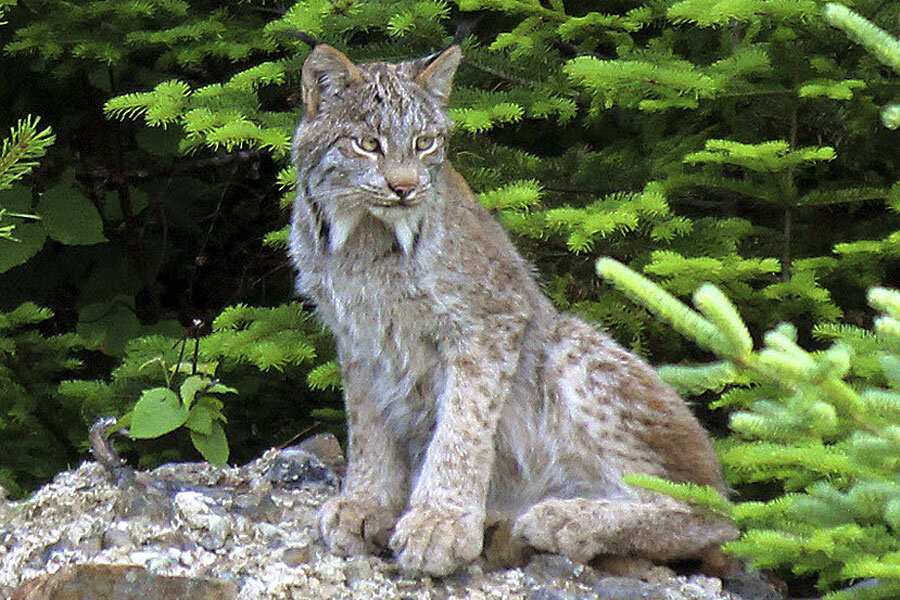Can Maine landowners save the Canada lynx from decline?
Loading...
| Township 4 Range 11, Maine
The kind of clear-cutting that made the woods of Maine an ideal hunting ground for Canada lynx is a thing of the past, but wildlife experts are trying to recreate enough of that habitat to secure the thick-furred cat's future.
With forests maturing and clear-cutting tightly regulated, the U.S. Fish and Wildlife Service and private landowners are working together to avoid a precipitous decline of lynx in the state with the biggest population of them in the contiguous U.S.
The goal is to provide patches of young spruce-and-fir forests that look like thickly wooded Christmas tree farms, the preferred habitat for the snowshoe hares on which lynx feed, said forester Scott Joachim.
"It's just a matter of providing the right habitat for their lunch," he joked.
Maine has 500 to more than 1,000 Canada lynx, an unnaturally large population of the tuft-eared felines that is the result of decades of habitat changes tied in large part to a pest infestation.
An outbreak of spruce budworm threatened large swaths of forest and prompted massive clear-cutting in the 1970s and '80s. Thickets of spruce and fir that emerged from the clearings provided an ideal habitat for snowshoe hares. But those forests are now maturing and clear-cutting has fallen off after an outcry over decimated forests led to tightened restrictions in 1989.
Declining habitat spells trouble for lynx and its primary prey, which gets its name from shovel-like paws that allow it to glide over deep snow in the winter.
"We're not managing for lynx," Joachim said. "We're managing for the habitat that provides the greatest number of snowshoe hares."
If nothing is done, the state could lose up to 60 percent of the snowshoe hare habitat — and 60 percent of its lynx — within 14 years, according to an estimate by the University of Maine.
The federal government is compiling the best available science on current threats to Canada lynx and assessing the future viability of the lynx populations in the lower 48 states. Designations of critical habitat already have been made in parts of Maine, Wyoming, Washington, Montana, Idaho and Minnesota.
Information gleaned during the process will be used in determining whether a formal recovery plan is needed for lynx, which were designated a threatened species in 2000, said Jim Zelenak, a biologist with the U.S. Fish and Wildlife Service in Montana.
The government and landowners are already taking action.
Out West, the government has had success in managing land to create the proper habitat to give lynx a chance because so much land is federally owned.
In Maine, where virtually all the vast northern wilderness is privately owned and much of it is managed for logging, the Fish and Wildlife Service is working with four large property owners that together control 600,000 acres of woodlands to create enough habitat to provide foraging for the lynx.
Through the Healthy Forest Reserve Program, landowners like Katahdin Forest Management are compensated for developing plans to help lynx and the pine marten, a type of weasel.
"You're trying to produce balsam fir and spruce fir so thick that you can't walk through it," said Mark McCollough, an endangered species biologist for the Fish and Wildlife Service.
West of Baxter State Park, Katahdin Forest Management is using selective clear-cuts along with cutting of mature trees to create the thick new-growth forest habitat, said president Marcia McKeague. The goal is to create contiguous sections of spruce and fir in the 12- to 35-foot-tall range on some of the 200,000 acres, she said.
The state is also managing 22,000 acres owned by the Maine Bureau of Parks and Lands for lynx habitat to mitigate losses from a state trapping program, said Joe Wiley, a state wildlife biologist.
Forest management techniques are necessary to create a balance of new and old growth habitat because natural pests like spruce budworm and natural disturbances like wildfires or harsh weather aren't enough to make way for young trees in Maine, said Jennifer Vashon, the state's lynx biologist.
For now, Joachim said, there are plenty of lynx, and he wants to keep it that way. They're elusive in the summer, but he's seen about a dozen or so in winter conditions.
"They're not like most critters in the woods that take off the moment they see you," he said. "They're the only species that will consistently stop and watch you. They're curious."
Copyright 2015 The Associated Press. All rights reserved. This material may not be published, broadcast, rewritten or redistributed.







